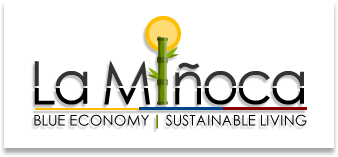Many farms are not connected to a sewage system, with expensive drinking water being used to flush the toilets and send the black-water into the local creeks. ZERI introduced the toilet design of ecological architect Anders Nyquist of Sweden, a simple yet sophisticated device that respects nature’s wisdom in keeping solids and liquids separate from each other. After about two years of curing the solids are used as valuable compost on the farmland. This toilet can save a family 100 liters per day of drinking water.
Nyquist’s dry toilet allows for separation of solid (stool) and liquid (urine) human waste.
Urine is high in nitrogen, moderate in phosphorus and low in potassium and can act as an excellent high-nitrogen liquid fertilizer. The urine is collected in a tank connected to the dry toilet and is diluted 1 to 8 to irrigate the soil around the plants.
The solid waste is full of microorganisms which are eliminated naturally after a one year maturation in a dry environment in which it is mixed with other organic kitchen waste and earthworms to obtain rich compost for plants.
The rest of the toilets of the house have been changed to flushable toilets. The water for the toilets comes from rain water and gray waters collected by the house. Maintaining the philosophy of sustainability and reduced waste.
All drawings are courtesy of Carolina Salazar – Architect, as well as pictures indicated with *
